Iberico de bellota: The traditional Spanish meat that’s all about slow food and sustainability
It takes five years to make, following old practices and working with nature. Emma Henderson finds out what makes these little slices of jamon just so good

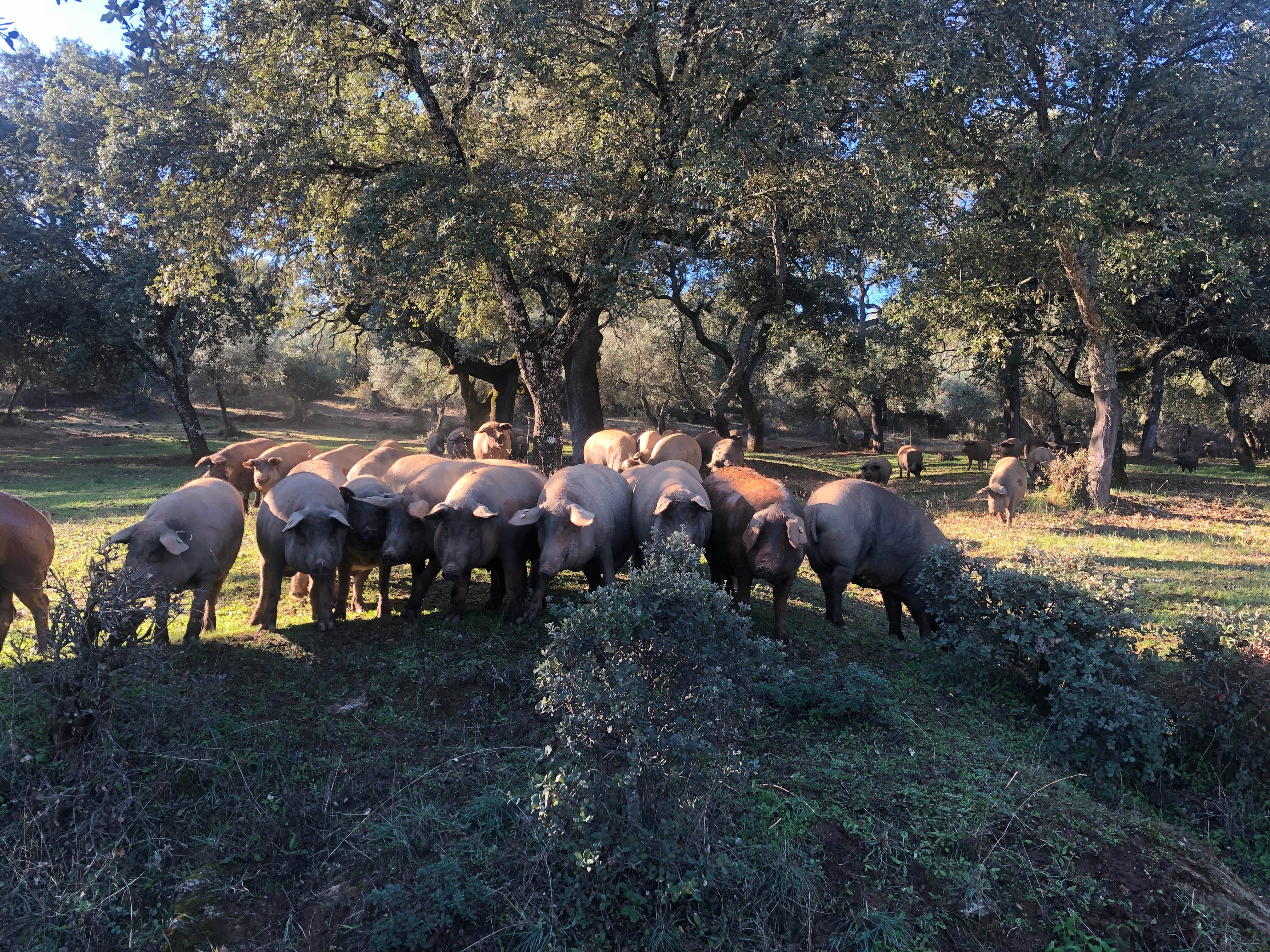
The low winter sun dapples through the leaves directly above where I’m standing, in a beautiful forested area known as a dehesa – a protected zone for grazing animals that works as its own little ecosystem.
It’s a sunny, crisp December morning in Dehesa Huerto del Llano, in southwest Spain, very close to the Portuguese border. There’s mossy grass underfoot and the area is dotted with acorn trees, as well as some olive, pine and shrubs covering about 700 hectares. I’m here to find some pigs. Beautiful black piggies, to be precise, who are trotting around in herds, searching for food.
These aren’t just any old pigs, though, and they’re not looking for any old food either. These are 100 per cent acorn-fed Iberico pigs, who rely on the fallen acorns (otherwise known as bellota) in this dehesa for sustenance.
These pigs are known as pata negra (which means black hoof) for their recognisable black feet. The meat they produce, Iberico de bellota, is the highest quality Iberico ham available in Spain, which is without a doubt one of the country’s best exports.
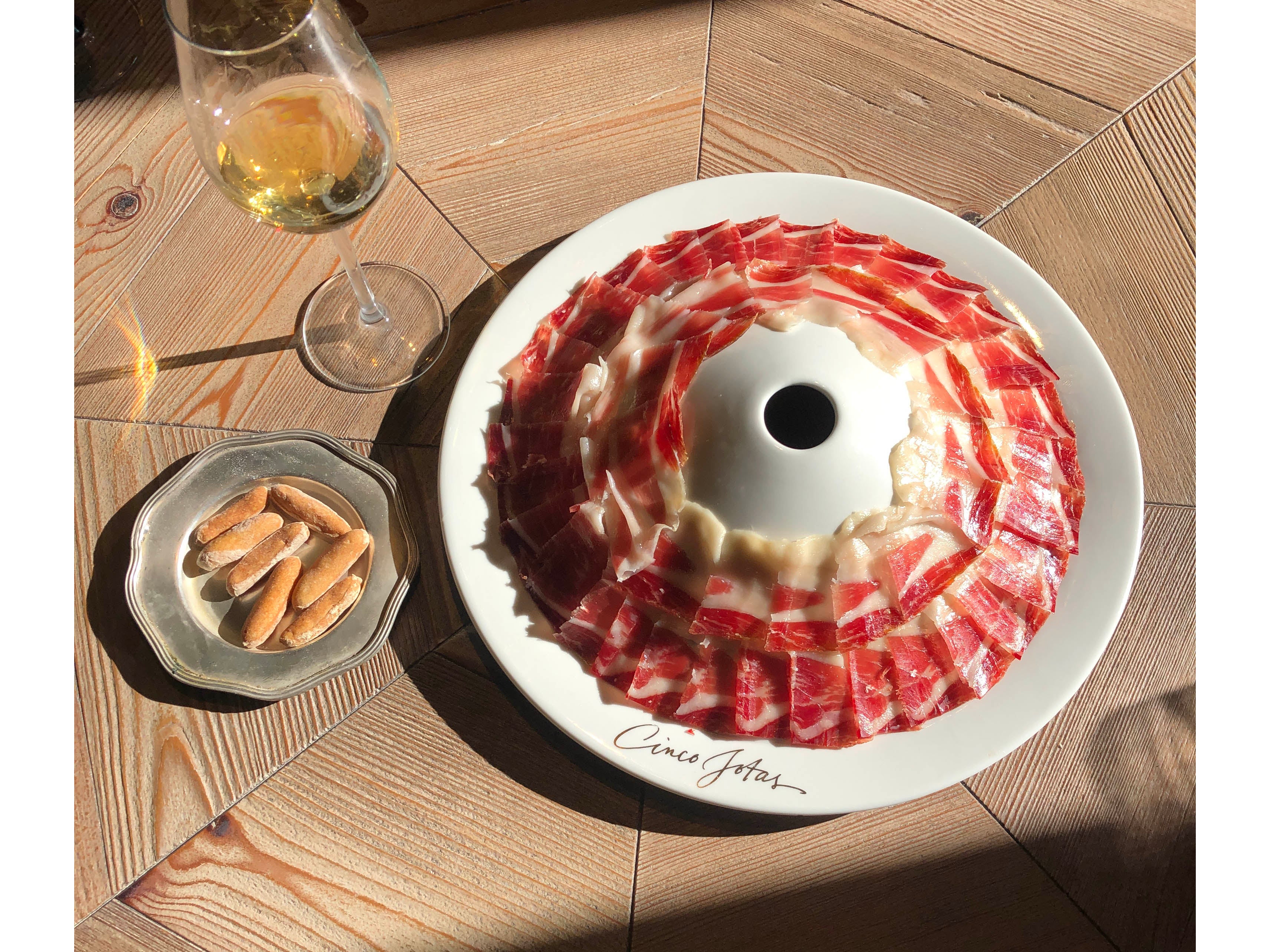
In the UK, you can find this exact Iberico de bellota at Spanish chef José Pizarro’s London restaurants, and he’s here with us. He’s enjoying seeing the pigs as much as me, but of course he’s already met them. He’s from nearby in the Andalusia region and uses plenty of the fantastic produce available here, from the meat to the wine (and even gin) in his restaurants back in London. He’s even got his name – literally – on some drying hams in the cellar of the area’s biggest producer of the meat, Cinco Jotas, in the nearby town of Jabugo, where these pigs will soon end up. But more on that later.
Spain produces an estimated 40 million of these hams a year, but it’s not fast food: from being born to being sold takes around five years
Much like all cured meats, making 100 per cent acorn-fed Iberico ham has become an art from. It takes a lot of time, but not all Iberico ham is the same. It comes in four categories: black, green, red and white. The latter is the lowest, and is mixed with parma ham, while black is the top grade – the real good stuff – and is what we’re here to taste and learn about.
Iberico ham labels Black label: Iberico de bellota This is the highest quality, and must come from 100 per cent pure-bred Iberico, free range, acorn-fed pigs. In order to be called free range, there must be no more than two pigs per hectare of space. These are hung to dry for at least 24 months, if not longer. Red label: Iberico de dellota These are not purebred pigs, but they need to be at least 50 per cent Iberian black pig, and then are crossbred with more commonly found pigs. They’re also free to roam and have an acorn diet. Green label: Jamon Iberico cebo de campo Again, these are 50 per cent Iberico bred pigs only, and although they do eat acorns, they’re also fed grain too, meaning the flavour and characteristic of the meat is slightly different. White label: Iberico de cebo As the lowest form of the ham, the main difference here is that these pigs are not free range and are only fed grain, and so don’t have the nutty flavour associated with the highest grade of meat. They are also 50 per cent Iberican bred. |
The quality of the meat is judged by its ruby red colour, striped appearance, and glistening pearly white fat. There’s a sweetness to the ultra-thin oblong slices, thanks to that delicious, umami-laced fat and an undeniable nuttiness, owing to the pigs’ specialist diet.
But what makes this meat the creme de la creme? It’s the way they live, eat and move. Spain produces an estimated 40 million of these hams a year, but it’s not fast food: from being born to being sold takes around five years. First of all, their lifespan is double that of a pig raised for slaughter, at around 22 months. The animals naturally fatten during this time, unlike non-Iberico pigs which are quickly and intensively fattened. On average, these free range pigs walk about 14 kilometres a day, roaming around their little forests and grasslands seeking out golden acorns to munch on. This exercise makes them lean, so it takes them longer to reach the required weight before slaughter. There are strict rules on the weight of a pig before slaughter, too – if it’s underweight, it won’t be accepted.
Cinco Jotas is still a family run business that hasn’t changed its air drying process since 1879, although changes in the climate over the decades have moved the operation below ground
Of course, with cured ham, the process doesn’t end with the slaughter. It can be a very serious business. Cinco Jotas is one of the largest Iberico de bellota producers in the country. Its name means “five star”, which is a smart, if not bold, name, pointing to its excellent ethos and the way it cares for these animals, from birth right through to being sold. It’s still a family run business that hasn’t changed its air drying process since 1879, although changes in the climate over the decades have moved the operation from the open-air courtyard down into the temperature-controlled cellars below ground.
As the process is so complex and respected, it has been afforded one of Spain’s highest possible protections
The curing is a real science that has been honed over time, and, incredibly, it’s all done by hand. During the tour of the cellars, there’s surprisingly little technology to see, as it’s mostly done through the circulation of air through small vent-like windows. Too much mould on one side of the meat and the hams are moved to another area, and so on.
As the process is so complex and respected, it has been afforded one of Spain’s highest possible protections, similar to the EU’s protected “destination or origin” title that protects much-loved British produce like Cornish clotted cream or Melton Mowbray pie. In short, it’s not to be messed with, but that doesn’t stop some trying to imitate the product, while still charging a premium price. You don’t need me to tell you to be sure to always read the label and know what you’re buying.
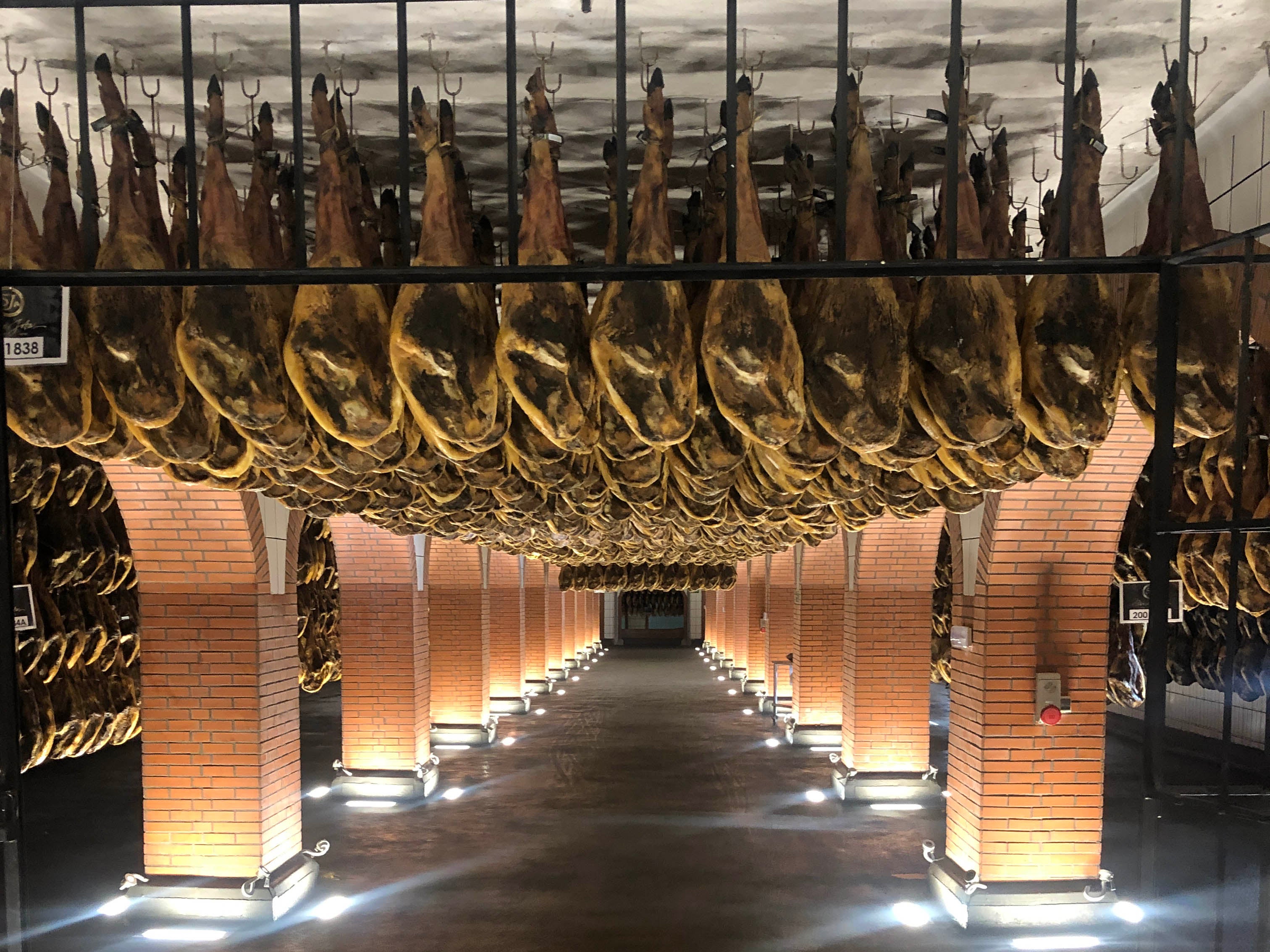
Back in the cellar, the hams go through rigorous testing to ensure they’re ready to move onto the next stage of the curing process. Before it’s packaged up and sent off to its destination, whether that’s restaurants like José’s in London or somewhere more local, it will only leave if it passes the final stage: a sniff test. Yes, really. It’s a serious business, conducted by a calador, whose sole job is to sniff the meats. They have to train for a long time and pass a very difficult exam to get the job. Four parts of the ham are tested, including just below the shank, next to the hop bone and around the join of the hip and femur bone. This is done by pushing a little tool, called a cala, into the meat and then giving the tool a sniff. The calador has the final say. If it’s not right, this little piggy will not be going to market. Back on the rack it goes.
Caladro Manolo Vega is testing some meats, and shows us the difference. I’m given one that smells right and will pass, and then one that won’t. I think I can tell the difference, but that might be because someone in an official coat with a dedicated sniffing tool is telling me so.

Further into the cellar, the smell of rich meat intensifies, a salty bacon-like scent thick in the air. At any one time, there’s thousands of hams drying down here, but we actually manage to find José’s hams with his name on. He hand chose them last year. You can expect to see one of these very hams in his restaurants in the near future. There’s a tangible satisfaction to seeing the full process of making something like this. It’s also fascinating to see the care and precision chefs like José take to serve the best quality products at their restaurants.
To me, it’s evident why buying this gorgeous type of jamon is expensive – all that goes into it, from field to fork, is a time intensive, laborious job, mostly done by hand. The end result is incredible. “People often ask me why a whole jamon leg is more expensive at my restaurant to buy than on Amazon,” says José – a recurring problem for this kind of premium product, I’m sure, and it’s understandable… until you know the process.
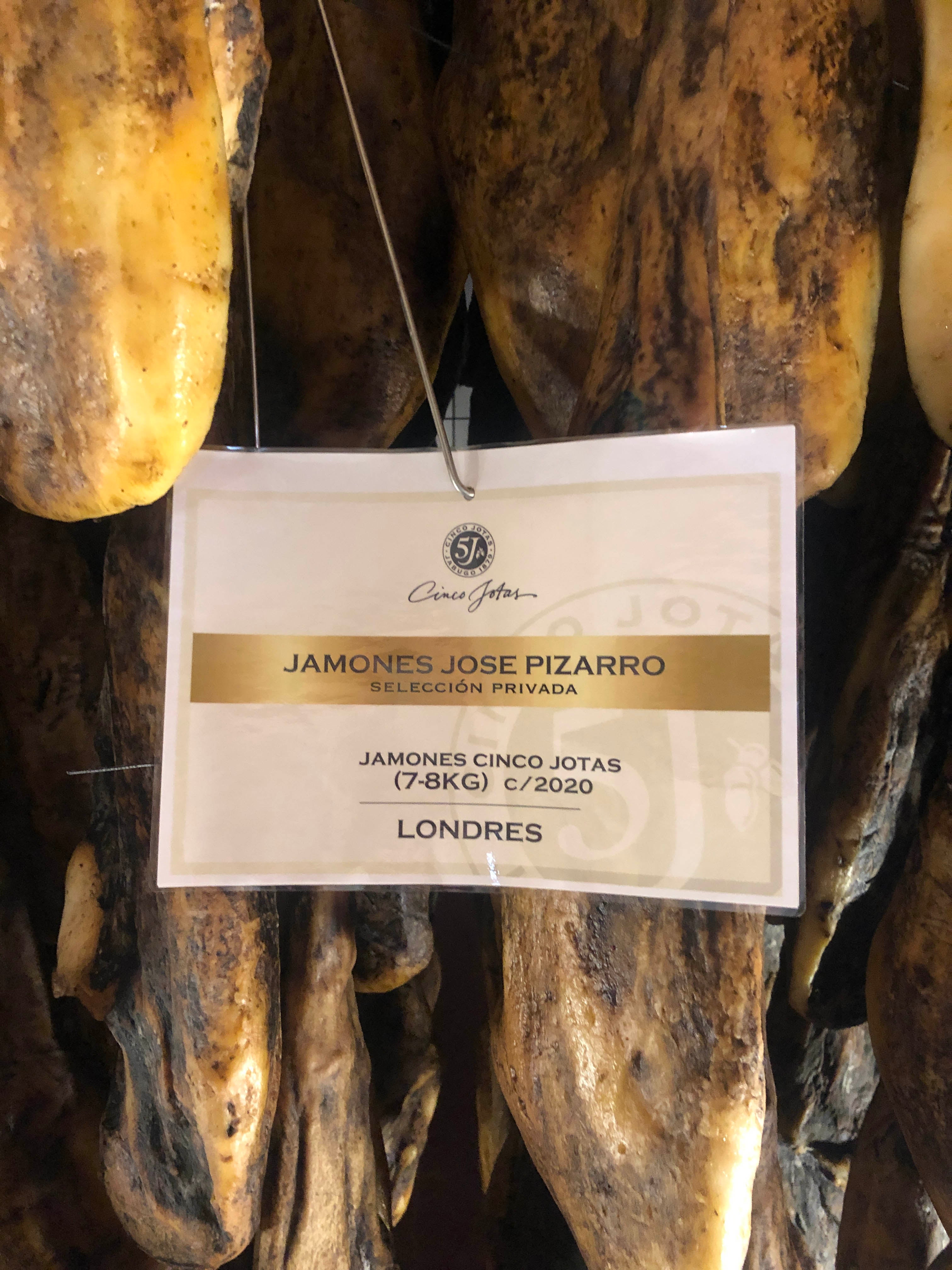
That process doesn’t end when it’s sold, though. The final chapter of the story is the carving, and just like every other job in this business, it’s an important one that takes a long time to master. I get the chance to have a go myself, and I can confirm: it’s absolutely not as easy as these skilled masters make it look, wielding an extremely long and thin blade, known as a cuchillo jamonero, to carve a perfectly thin slice of meat.
There’s plenty to consider when carving, from knowing how to secure the leg in the jamonero holder, and how to use all the tools (there’s lot, including a small pair of tweezers), to properly holding the blade the right way (note: far down), and the amount pressure to apply (too much and you end up with ridges, and if it’s not even you could cut it too thin, or rip it before the desired size is cut). Naturally, the master cuts a wafer thin piece of meat, without any ridges, or evidence that it wasn’t just peeled off like Sellotape.
After one rather feeble attempt, I gladly hand the knife back to the real carver, Severiano Sanchez, who has been doing it for 32 years. Embarrassed at my rather thick and ridged attempt, I’m worried I’ve made a huge dent in a very expensive piece of meat. Of course, he’s so skilled he can instantly rectify it. Phew.
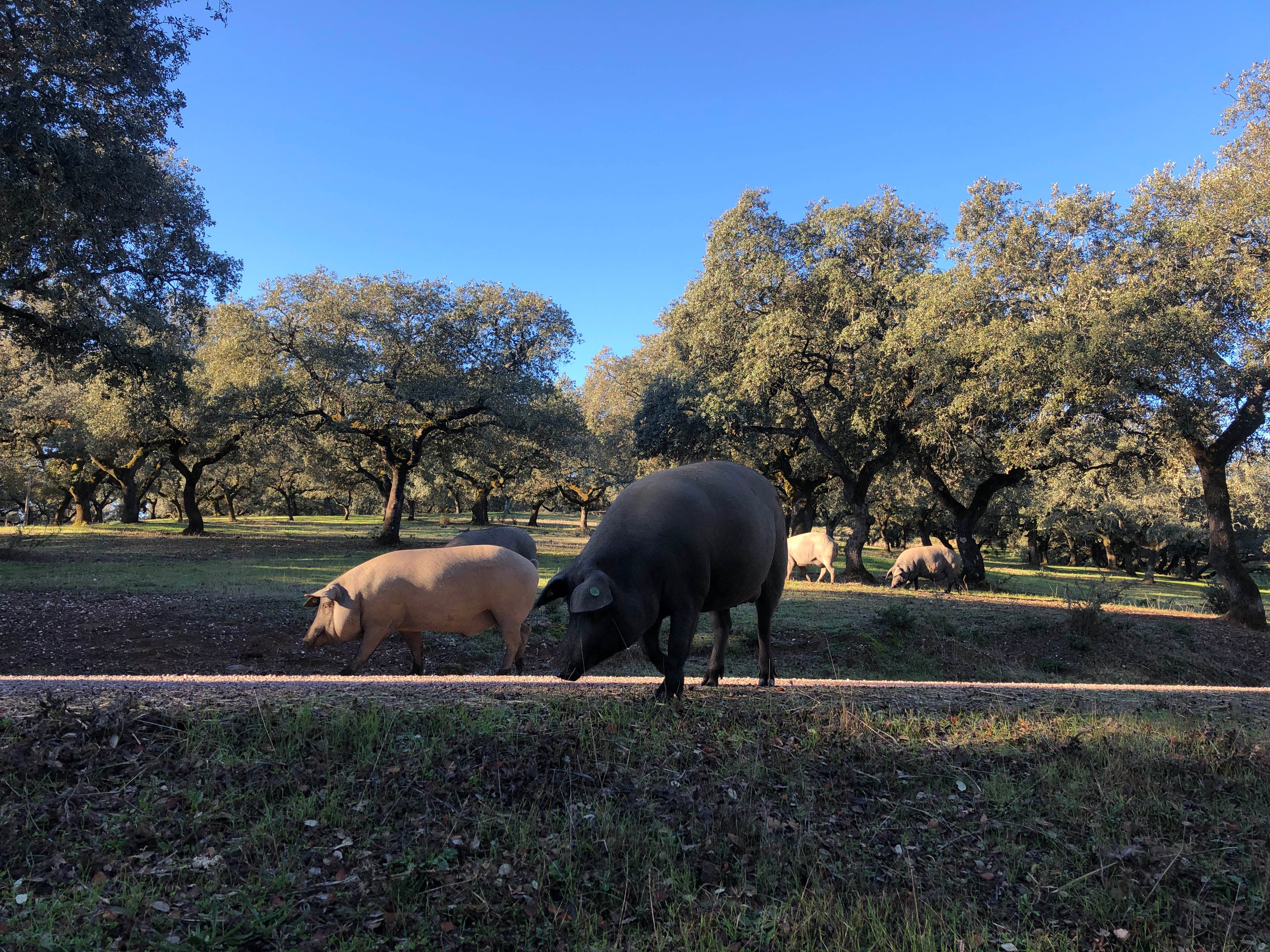
To end the day, we’re served the iridescent ruby pieces with sherry, another of the country’s proud exports. Don’t confuse it with the sweet stuff from Crofts that your nan drinks, though – we’ve overlooked this fortified wine and pigeon-holed it as something it’s not.
Sustainability is such a buzzword, and often overused – if not gravely misused. But the production of this meat is one of the best examples of real slow food. Following a life of roaming where the only aim is snuffling up acorns, these prized little Spanish piggies got to market, and ended up on my plate – it only took them five years to get here. But it’s certainly worth the wait.
Where to buy Iberico de bellota: Read our IndyBest round-up of the best Iberico de bellota
Join our commenting forum
Join thought-provoking conversations, follow other Independent readers and see their replies
Comments
Bookmark popover
Removed from bookmarks